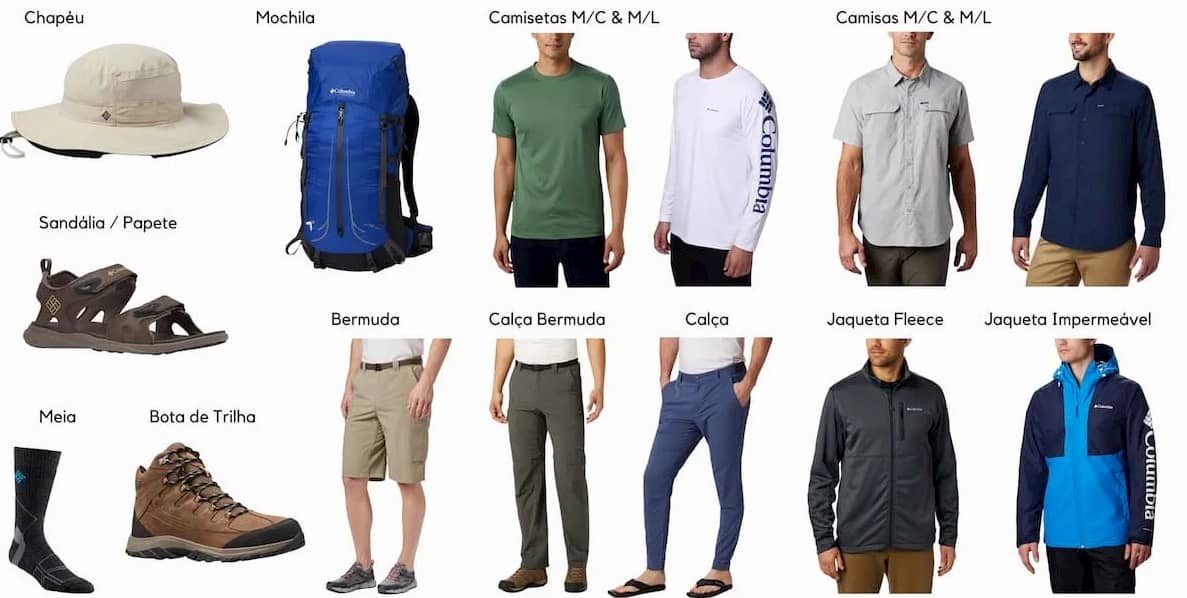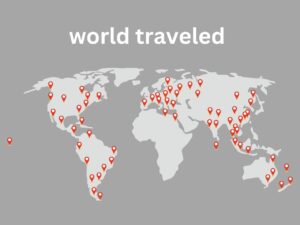Clothing for traveling offers us several challenges.
We always come across several questions such as:
What should I wear? How many clothes should I bring? What should I take?
Gear aside, packing your clothes for a trip may seem overwhelming at first, but using some smart techniques can ease the stress.
When traveling, especially to another country, it’s best to pack some lightweight clothing that works for all types of situations – from city walks to exploring nature.
This article provides the basics of what to buy and how to pack.
This means you will have a more pleasurable trip with much less stress before, during and after the trip.
See in this article how to travel with just your hand luggage and save 50% on your ticket.
First secret is to wear multi-purpose clothing.
The first secret to packing smart luggage is finding a few key pieces that you can use practically anywhere and at any time of the day.
To achieve this, your clothes must have certain characteristics.
Technical fabrics:
Breathable fabrics that absorb moisture, dry quickly and are easy to care for.
Use neutral colors:
As luggage space is limited, take neutral colors – brown, black and khaki – especially for pants, shorts and skirts. These colors go well with everything and all occasions.
That knead little:
Consider fabrics that wrinkle less, this doesn’t mean they don’t wrinkle, but with it being much less it reduces the need to iron during the trip.
Neutral Style:
The ideal when going to new cultures is not to be in the spotlight, as you don’t know what could cause misunderstandings.
Furthermore, it can prevent a robbery or violence.
Mainly religious or moral issues, women should avoid tight clothing or very short shorts and skirts.
This type of clothing may not be acceptable in some cultures or locations.
Solar protection:
Generally, when traveling, your exposure to the sun is very high.
Wearing sun-protective clothing features an ultraviolet protection factor (UPF) rating against UVA and UVB rays. Clothing with UPF 50 blocks 98% of UV rays.
Sun protection clothing is rated from 15 (good) to 50+ (excellent), and this protection never comes off or sweats away.
This means you save on sunscreen, as well as protecting yourself much better with clothes than with creams.
Insect Protection:
Insects can be a real nuisance. Even worse, in some areas, such as countries with many forests, swamps, etc.
We have more diseases transmitted by mosquitoes such as Lyme disease, dengue fever, malaria. Some clothing lines, like the ExOfficio® Insecto Shield collection, are treated with permethrin, an insecticide developed specifically for fabrics, to protect skin from insects.
Effective against ticks, mosquitoes and dozens of other insects, permethrin has been used safely for decades and its use is recommended by the CDC (Centers for Disease Control and Prevention).
Pockets:
They become especially useful Your clothes have some.
Some tips:
Shirt pockets: Ideal for tickets, sunglasses or other small items.
From pants and skirts: some incorporate hidden pockets for passport or money, which can be more comfortable than wearing a separate money belt underclothing.
Zippered: Provide better security against loss or theft than button closures.
The second secret is to dress in layers.
One of the biggest factors that influence your trip is the weather.
When traveling internationally, this can be one of the main critical factors for the success of your trip.
Sometimes we are in summer and go to winter, other times we are in dry weather and go to rainy places.
Even if the change is not drastic, the weather can be unpredictable.
See my trip to Patagonia, where I left El Chalten with 25 degrees, then got rain and even snow and when I returned to the city it was very sunny, all in one day.
This tried-and-true strategy allows you to regulate comfort by layering and taking off as your activity level or the weather changes.
How to layer:
To understand the layers of your outdoor clothing, you need to know the function of each layer:
Base or Intimate Layer: Moisture Management
As it is the layer closest to the skin, the function of the base layer is to wick perspiration away from the skin.
This keeps the skin dry, regulating the temperature.
Middle layer: insulation
The insulating layer helps retain the heat radiated by your body. The more efficiently this layer retains heat, the warmer you will be and protected from the cold.
Outer layer: protection against rain, wind and snow.
Most allow at least some perspiration to escape (breathable).
Your outer shell is an important piece in stormy weather because if wind and water penetrate the inner layers you can get very cold.
Even if you don’t use all three layers right away, it’s always a good idea to take all layers with you on each outing. You never know when you will need it.
Example of clothes per layer.
Outer layer of protection: Jackets
In rainy weather, stay dry and comfortable with waterproof/breathable and water-resistant/breathable rain wear.
We have two levels of waterproof/breathable jackets with laminates like Gore-Tex® or eVent® are your best choices for a variety of climates and activities.
However, these jackets are more expensive than other rain wear.
Rain resistant jackets with fabric linings offer a more affordable alternative, but are less resistant to rain.
Water-resistant/breathable jackets repel wind and light rain while providing excellent breathability when you’re active.
They are less bulky and cheaper than other waterproof jackets, but are not designed for significant rainfall.
Intermediate or insulating layer:
Pants/shorts/skirts/dresses
Shorts, skirts and dresses are the obvious choice when traveling to a hot or tropical destination. But remember that long pants provide better protection from the sun, insects and rain. And, as mentioned above, you may need to use them for cultural reasons as well.
Convertible pants have legs that can be easily removed into shorts. These are a great space-saving option.
Shirts/Blouses/tops
They work well for travel, especially in hot weather, because they wick away moisture to keep you cool.
It’s important to always have the long sleeve option, even if you’re heading to a hot climate. As with long pants, a long-sleeved shirt will protect you from the sun, bugs and rain. Some considerations:
Always carry a hat/caps.
They not only protect your head, but also your face from the excess sun that is exposed. Thus avoiding the problem of sunburn, in addition to protecting against skin cancer and other diseases.
Base or underwear layer: Underwear and socks
The same fabric rules apply to underwear and socks: a synthetic fabric is easier to care for than cotton, while merino wool products offer natural breathability and comfort.
When choosing socks, be aware that synthetic materials and wool can help prevent blisters, keeping your feet drier than cotton socks.
Third secret is not to take what you are not going to use.
The ideal is to plan for a week and if you stay two, you can multiply it by two.
However, if you are staying longer than two weeks, consider washing your clothes.
I really like using the 1-2-3-4-5-6 ratio when packing:
1 hat, 2 pairs of shoes, 3 pairs of pants or skirts, 4 shirts/blouse, 5 pairs of socks and 6 sets of underwear.
If you have something special planned, just add it to your suitcase.
Since weather is difficult to predict when you are traveling for three weeks or more, layering solves this issue.
Now that you know how to choose your clothes for the trip and are looking for what to buy, you will come across a lot of names, types and technology, and you will be unsure of which is best.
Below is a small comparison summary of the main fabrics available.
Fabrics should breathe well, move moisture away from the skin and dry quickly.
Cotton, while suitable for casual wear, is generally less travel-friendly than the fabrics listed below.
Your most common choices:
Nylon and polyester:
Most performance fabrics feature any of these synthetic materials.
Some famous brands include CoolMax® polyester or Cordura® nylon.
Pros: Breathable, lightweight, moisture-wicking and quick-drying, resists pilling and abrasion.
Cons: Feels a little less comfortable than cotton.
Tencel® and polynosic rayon:
Tencel is a brand of lyocell, a wood pulp-based fiber that is part of the rayon family. Tencel and Polynesian rayons offer similar fit and comfort, plus machine wash/dry convenience.
Pros: Silky smooth feel, dries quickly and resists wrinkles; Tencel is made using an environmentally friendly process.
Cons: Does not absorb moisture as well as polyester or nylon.
Silk:
Luxuriously soft, it is best used in underwear.
Pros: Lightweight, breathable, durable – ideal for hot climates.
Cons: Less durable than other materials.
Cotton:
This is commonly used for casual and versatile styles.
Pros: Soft, durable, breathable, versatile, easy-care style
Cons: Does not absorb moisture or dry as quickly as nylon or polyester
Cotton/polyester blend:
Another common fabrication for casual wear, this blend seeks to offer comfort and performance.
Pros: It’s soft on the skin, breathable
Cons: Does not absorb moisture or dry as quickly as 100% nylon or polyester
Plated fabrics:
“Lined” refers to garments with a fabric (e.g. cotton) on the outside, lined with another type of fabric (e.g. polyester) against the skin.
This approach is designed to offer the best attributes of both fabrics.





